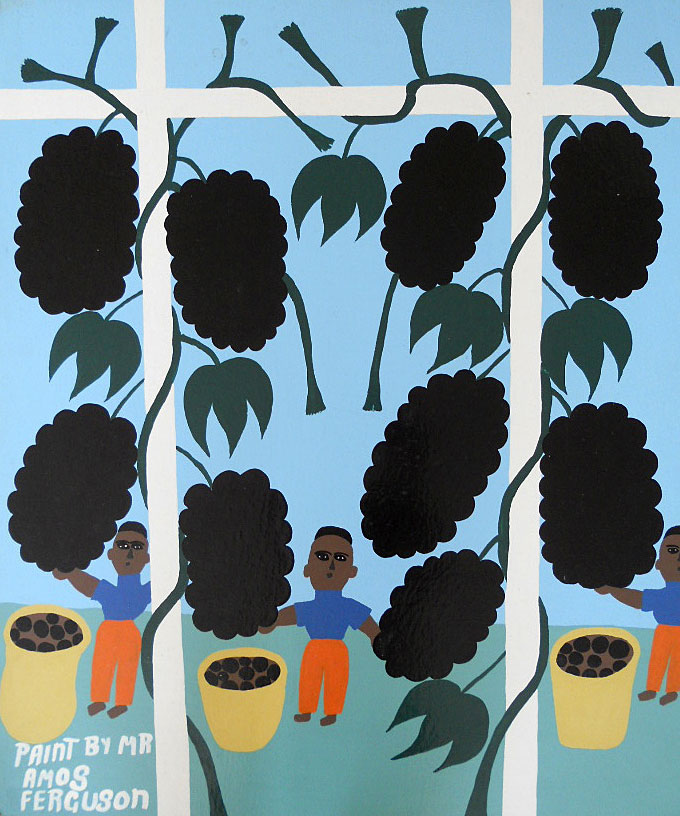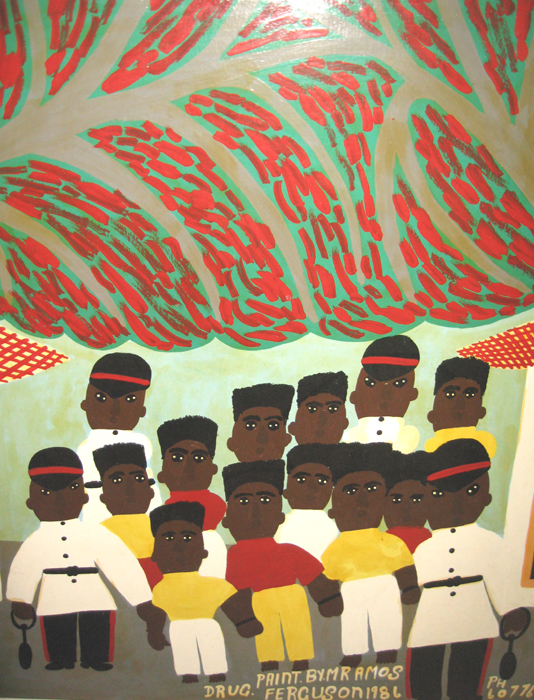
Amos Ferguson, 1920-2009, in Collection Studio Museum Harlem
Family Around the Table, 60’s
About:
(article in the New York Times)
October 30, 2009
Amos Ferguson, 89, Bahamian Artist, Is Dead
By WILLIAM GRIMES
Ladies in Orange, 2002.
Amos Ferguson, a folk artist known for his brilliantly colored Bible scenes and his depictions of the social rituals and the flora and fauna of the Bahamas, died on Oct. 19 at his niece’s home in Nassau. He was 89.
The death was confirmed by Dr. Erica James, the director of the National Art Gallery of the Bahamas.
Mr. Ferguson, a house painter by trade, did not turn to art until he was in his 40s, when, as he told the story, a nephew came to him and related a dream he had just had. Jesus, the nephew said, came out of the sea with a painting in his hands and said Mr. Ferguson was wasting his talent for painting.
Mr. Ferguson heeded the call and, painting with exterior enamel on cardboard, rendered Bible stories or Bahamian scenes in a vibrant Caribbean visual idiom. The work, sold at the Straw Market in Nassau, was discovered by a New York collector in the 1970s, and in 1985 the Wadsworth Atheneum in Hartford mounted the exhibition “Paint by Mr. Amos Ferguson” — taking the artist’s signature as the title.
Mr. Ferguson, previously unknown even to many Bahamians, leapt to the front ranks of the outsider-art genre.
Picking Grapes, 70’s.
“Until the 1950s or 1960s, we did not really have an artist who depicted us,” Ms. James said. “Amos was intuitive, but he tapped into the pulse of Bahamian culture. The seeming simplicity of the forms and the subjects gave him an audience abroad, and now here.”
Mr. Ferguson was born on Feb. 28, 1920, on the island of Exuma in the Bahamas. He was one of 14 children of a Baptist preacher and carpenter. At 14 he left home for Nassau, where he worked as an upholsterer, furniture finisher and house painter.
Goombay Ladies, 70’s
After receiving the call to become an artist, he set up at the foot of the bridge connecting Nassau to Paradise Island and began painting Bahamian scenes on cardboard sheets that his wife used in her basket making. When they failed to sell, he retreated to his house and concentrated on intensely personal religious paintings and brightly colored, joyous renderings of social rituals like the Junkanoo festival. He also liked to depict the island’s crabs, fish and flowers.
Beatrice, his wife, offered his paintings to tourists at the Straw Market, where she sold baskets and dolls. She died in 2000. He has no immediate survivors.
“He would paint on pizza boxes, shirt cardboard, drinking glasses, anything,” said Laurie Carmody Ahner, who sells Mr. Ferguson’s work at the Galerie Bonheur in St. Louis. “He was the ultimate recycler.”
Drugdealers, 1986.
The titles, with their shaky spelling and grammar, were evocative: “When I Was Nine Years Old I Dream About Black Crab and Snake,” “This Picture Is When Noah Was Bilding the Ark” or “Jesus Hung on the Cross for You Sin and My Sin. They Plat Crown of Tones and Place It on His Head.”
“I paint by faith, not by sight,” Mr. Ferguson often said.
He began showing at galleries in the Bahamas in 1972, but widespread recognition came to him after 1978, when Sukie Miller, an American collector, bought several of his paintings. She showed them to Ute Stebich, a dealer in Haitian art in Lenox, Mass.
The two women traveled to Nassau, photographed the work and sent slides to the Wadsworth Atheneum, hoping that the museum might acquire some paintings for its African Diaspora Collection. Instead, curators organized a show of 50 works, which brought Mr. Ferguson to the attention of the international art market. His images were later used to illustrate “Under the Sunday Tree” (1991), a collection of poems by Eloise Greenfield.
Exposure abroad helped win Mr. Ferguson new respect in the Bahamas, where fame had been slow to come. “Used to be, I could count the people in the Bahamas who understood my work,” he told United Press International in 1985. “But now they just believe and see what I’m doing. The eyes were in darkness. As time rolls on, they come into the light.”
In 2005 the street he lived on in Nassau was renamed Amos Ferguson Street. He continued painting even after his eyesight began to fail.
Turkey, 1986.
“To paint, the Lord gives you a vision, a sight that you go by,” he once told a reporter. “But don’t forget you have to see and check that Bible and don’t forget God. And the more you keep up with your Bible, and get the understanding, the better you paint.”





